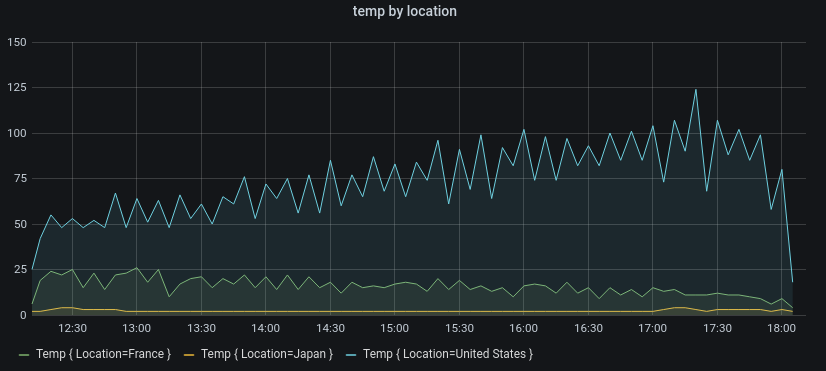Time series dimensions
At the end of the “Time series databases” section of “Introduction to time series”, the concept of labels, also called tags, is introduced:
Another feature of a TSDB is the ability to filter measurements using tags. Each data point is labeled with a tag that adds context information, such as where the measurement was taken. …
With time series data, the data often contain more than a single series, and is a set of multiple time series. Many DranSCADA data sources support this type of data.
The common case is issuing a single query for a measurement with one or more additional properties as dimensions. For example, querying a temperature measurement along with a location property. In this case, multiple series are returned back from that single query and each series has unique location as a dimension.
To identify unique series within a set of time series, DranSCADA stores dimensions in labels.
Each time series in DranSCADA optionally has labels. labels are set a of key/value pairs for identifying dimensions. Example labels could are {location=us} or {country=us,state=ma,city=boston}. Within a set of time series, the combination of its name and labels identifies each series. For example, temperature {country=us,state=ma,city=boston}.
Different sources of time series data have dimensions stored natively, or common storage patterns that allow the data to be extracted into dimensions.
Time series databases (TSDBs) usually natively support dimensionality.
In table databases such SQL, these dimensions are generally the GROUP BY parameters of a query.
In SQL or SQL-like databases that return table responses, additional dimensions usually columns in the query response table.
For example, consider a query like:
SELECT BUCKET(StartTime, 1h), AVG(Temperature) AS Temp, Location FROM T
GROUP BY BUCKET(StartTime, 1h), Location
ORDER BY time asc
Might return a table with three columns that each respectively have data types time, number, and string.
| StartTime | Temp | Location |
|---|---|---|
| 09:00 | 24 | LGA |
| 09:00 | 20 | BOS |
| 10:00 | 26 | LGA |
| 10:00 | 22 | BOS |
The table format is long formatted time series, also called tall. It has repeated time stamps, and repeated values in Location. In this case, we have two time series in the set that would be identified as Temp {Location=LGA} and Temp {Location=BOS}.
Individual time series from the set are extracted by using the time typed column StartTime as the time index of the time series, the numeric typed column Temp as the series name, and the name and values of the string typed Location column to build the labels, such as Location=LGA.
If the query is updated to select and group by more than just one string column, for example, GROUP BY BUCKET(StartTime, 1h), Location, Sensor, then an additional dimension is added:
| StartTime | Temp | Location | Sensor |
|---|---|---|---|
| 09:00 | 24 | LGA | A |
| 09:00 | 24.1 | LGA | B |
| 09:00 | 20 | BOS | A |
| 09:00 | 20.2 | BOS | B |
| 10:00 | 26 | LGA | A |
| 10:00 | 26.1 | LGA | B |
| 10:00 | 22 | BOS | A |
| 10:00 | 22.2 | BOS | B |
In this case the labels that represent the dimensions will have two keys based on the two string typed columns Location and Sensor. This data results four series: Temp {Location=LGA,Sensor=A}, Temp {Location=LGA,Sensor=B}, Temp {Location=BOS,Sensor=A}, and Temp {Location=BOS,Sensor=B}.
Note: More than one dimension for SQL data sources is currently only supported in the Analytics services with the Azure monitor service as of version 7.1. Support for SQL data sources such as MySQL, Postgres, and MSSQL is planned to be added for 7.2.
Note: Multiple dimensions are not supported in a way that maps to multiple alerts in DranSCADA, but rather they are treated as multiple conditions to a single alert. See the documentation on creating alerts with multiple series.
In the case SQL-like data sources, more than one numeric column can be selected, with or without additional string columns to be used as dimensions. For example, AVG(Temperature) AS AvgTemp, MAX(Temperature) AS MaxTemp. This, if combined with multiple dimensions can result in a lot of series. Selecting multiple values is currently only designed to be used with visualization.

